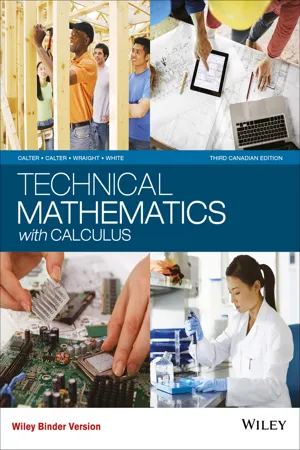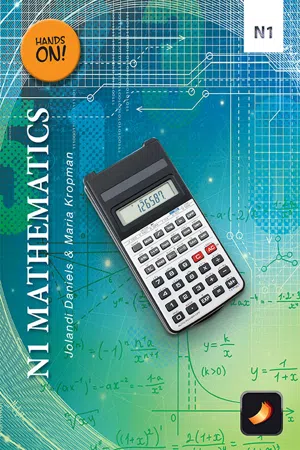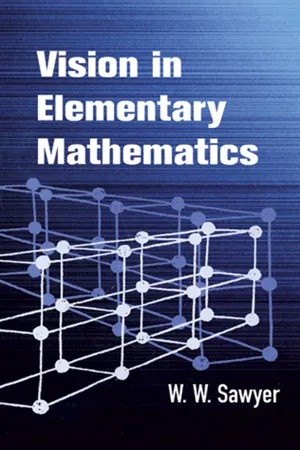Mathematics
Algebraic Fractions
Algebraic fractions are expressions that involve both algebraic terms and fractions. They are formed by dividing one algebraic expression by another and can include variables in the numerator and/or denominator. Simplifying algebraic fractions involves factoring, canceling common factors, and applying the rules of operations for fractions. These fractions are commonly used in solving equations and simplifying complex expressions.
Written by Perlego with AI-assistance
Related key terms
1 of 5
3 Key excerpts on "Algebraic Fractions"
- eBook - PDF
- Michael A. Calter, Paul A. Calter, Paul Wraight, Sarah White(Authors)
- 2016(Publication Date)
- Wiley(Publisher)
9–1 Simplification of Fractions Parts of a Fraction A fraction has a numerator, a denominator, and a fraction line. fraction line a b numerator denominator Quotient A fraction is a way of indicating a quotient of two quantities. The fraction a/b can be read “a divided by b.” The two ways of writing a fraction, a b and a/b, are equally valid. Ratio We also speak of the quotient of two numbers or quantities as the ratio of those quantities. Thus the ratio of x to y is x y . 9 ◆◆◆ OBJECTIVES ◆◆◆◆◆◆◆◆◆◆◆◆◆◆◆◆◆◆◆◆◆◆◆◆◆◆◆◆◆◆◆◆◆◆◆◆◆◆◆◆◆◆◆◆◆◆◆◆◆◆◆◆◆◆◆◆◆◆◆ When you have completed this chapter, you should be able to: • Simplify fractional expressions. • Multiply and divide fractional expressions. • Add and subtract fractional expressions. • Simplify complex fractional expressions. • Solve fractional equations. • Solve word problems using fractional equations. • Manipulate and work with literal equations and formulas. You already know about fractions with numbers. In algebra, however, the numbers are replaced with letters, coefficients, and even entire expressions. Many equations and formulas in science and technology are in the form of a fraction. Since the rules of working with the numerators and denominators of fractions must be applied to entire algebraic expressions, we’ll need to make much use of the factoring techniques of Chapter 8 in order to simplify them. As we work with formulas that include fractions, we must be careful: it’s very easy to make mistakes when we cross multiply. Remember that any- thing you do must be done to each term on both sides of the equation. Also, don’t be intimidated by complex fractions where a numerator or denominator might contain a fraction; use your skills and take it one step at a time. Not all of this material is new to us. Some was covered in Chapter 2, and we solved simple fractional equations in Chapter 3. Fractions and Fractional Equations - Available until 8 Feb |Learn more
- J Daniels, M Kropman, J Daniels, M Kropman(Authors)
- 2014(Publication Date)
- Future Managers(Publisher)
92 Module 3 • Factorisation and fractions 3.2 Algebraic Fractions In this section monomial denominators will be covered. Fractions can be simplified by dividing the numerator and the denominator by the same factor. Example 4 8 ← ← numerator denominator = 4 1 4 2 × × • Cancel 4. = 1 2 or 4 8 = 4 8 2 1 • 4 divides into 8 twice. = 1 2 • The denominator of a fraction can never be equal to 0. a 0 is undefined, for example, 2 0 is undefined. • 0 a = 0, for example, 0 2 = 0 Pre-knowledge • You need to know the following when working with Algebraic Fractions. The laws of exponents. How to factorise expressions: common factor and grouping How to find the LCM. • Forms of fractions Fraction Examples Explanation Proper fraction 3 4 ; 2 7 ; – 7 9 ; 3 6 Numerator is smaller than denominator Improper fraction 6 5 ; – 11 4 ; 9 7 Numerator is bigger than denominator Mixed fraction 1 2 3 ; 5 3 7 ; 10 1 2 Whole number and a fraction 1 1 + 2 3 = 1 2 3 2 Equivalent fraction 5 10 = 1 2 ; 19 95 = 1 5 Multiplying the numerator and the denominator by the same number (except 0) results in a fraction equivalent to the given fraction. • Splitting up a fraction: a b c + = a c + b c • a b c + ≠ a b + a c • ( a + b ) 2 ≠ a 2 + b 2 • ( a + b ) 2 = ( a + b )( a + b ) = a 2 + 2 ab + b 2 93 N1 Mathematics| Hands-On 3.2.1 Simplifying fractions The numerators in the examples below are not equal to 0. Example 1 Simplify the following. Fraction Solution Explanation 1. 5 xy x ( x ≠ 0) 5 / / xy x = 5 y • Monomial numerator and denominator; x x = 1 2. 3 6 xy xz ( x ≠ 0; z ≠ 0) / / / / 3 2 3 xy xz . = y z 2 • 3 6 = / × / × 3 1 3 2 = 1 2 or 3 6 2 1 = 1 2 3. 16 4 3 2 2 2 ab c a bc − ( x ≠ 0; b ≠ 0; c ≠ 0) 4 4 4 3 2 2 2 . / -/ ab c a bc = – 4 2 b a • – 16 4 = –4; a a 2 = a 1–2 = a –1 = 1 a • b b 3 = b 3–1 = b 2 ; c c 2 2 = c 2–2 = c 0 = 1 • 16 4 − = – 16 4 • − − 3 3 = +1 = 1 • − 3 3 = –1 • − a b = a b − = – a b 4. - eBook - ePub
- W. W. Sawyer(Author)
- 2012(Publication Date)
- Dover Publications(Publisher)
x is no longer restricted to standing for some whole number. The picture will cease to apply but the result will in fact remain true.MANIPULATION OF FRACTIONS
At a certain stage in the learning of algebra children meet problems such as that of simplifying the expression:This is in fact a rather mild example of the sort of question that can be asked about fractions in algebra. This book has the limited aim of dealing with the beginnings of algebra, and detailed work on such fractions lies outside its scope. However, it seems worth while to take a brief look at the principles involved.To handle fractions in algebra successfully two things are necessary - an understanding of fractions in arithmetic, and the ability to see the connexion between fractions in arithmetic and fractions in algebra. Mistakes arise when either of these is lacking.The letters in algebra stand for numbers chosen at will. A step in algebra can be checked by putting particular numbers for the letters. If the check works whatever numbers may be selected, then the step is correct. For example, the step is correct. Whatever numbers we choose for a , b , c , we obtain a true statement in arithmetic (we tacitly assume that the letters b and c do not represent 0).On the other hand the step (?) is not justified. One can find numbers for a , b , and c that make it true; for example, if we take a , b , and c all to be 2, we get . But it is not true for all numbers. If we take 1 for a , 2 for b , and 1 for c , the equation becomes , which is certainly false. In fact the equation makes the false
Index pages curate the most relevant extracts from our library of academic textbooks. They’ve been created using an in-house natural language model (NLM), each adding context and meaning to key research topics.


